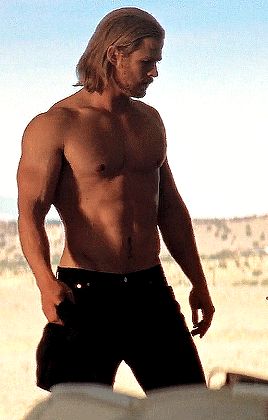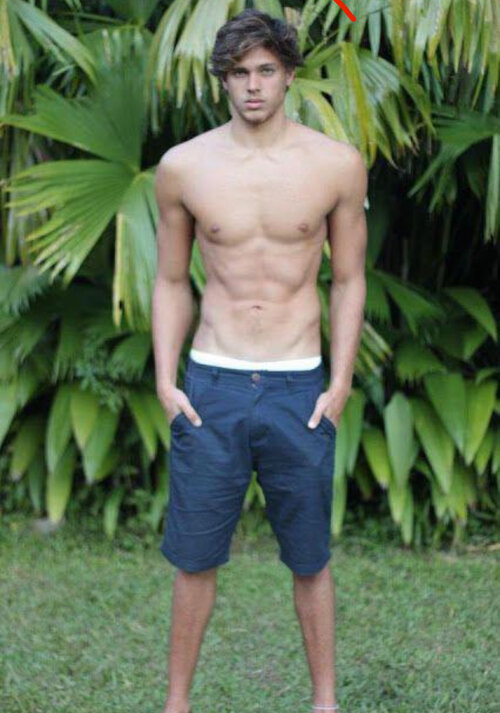Alexanderr

Admin
- Joined
- Mar 5, 2019
- Posts
- 22,481
- Reputation
- 48,159
This thread is dedicated to unpacking the research on what women find most attractive in male physiques. We'll dive into body composition, limb proportions, and specific muscles, drawing from evolutionary psychology and contemporary studies.

This'll mostly be a water thread, as I'm sure most of you guys know women don't prefer emaciated figures or steroid mass-monsters, but if you're like me and you’re curious about optimizing your appearance based on what women find attractive, this is for you.
Overall Body Composition

Women consistently prefer a lean, muscular physique—not overly bulky and certainly not emaciated. This ideal centers around a balance: low body fat paired with well-developed, proportional muscle mass.
The key trait is a physique that conveys strength and health without appearing unnatural or intimidating. Muscles should show definition and separation (low subcutaneous fat) but not to the extreme levels of competitive bodybuilders.
The goal is a functional and athletic build that signals vitality and physical capability while remaining approachable and relatable, rather than overly engineered or excessive in size.
 vs.
vs.

Research Findings:
Lean muscularity consistently outperforms both bulked-up and thin physiques in terms of perceived attractiveness, combining a strong and athletic appearance with approachability (Sell et al., 2017; Frederick & Haselton, 2007).
Body fat around 12-15% is considered the "sweet spot" for aesthetic appeal and health (Lassek & Gaulin, 2009).
BMI Considerations
The ideal BMI reported in studies (~26) is flawed because it doesn’t differentiate between muscle and fat. A muscular, lean man at this BMI can look vastly different from someone carrying excess body fat.
The emphasis is on natural appeal—a body that signals you’re athletic, fit, and disciplined but not artificially enhanced or obsessive about your appearance.

Women instinctively prefer physiques that align with evolved preferences, reflecting genetic fitness and health. Extreme muscularity, common only in modern bodybuilding, usually exceeds these preferences.
For example, world-class bodybuilders from the early 20th century had more natural, achievable physiques compared to today’s natural and enhanced bodybuilders.
This then suggests that the ideal lies closer to the lean, athletic builds of the past rather than the hyper-muscularity seen now.
 vs.
vs.

Natural bodybuilders then vs. natural bodybuilders now.
Limb Proportions

Proportions, too, play a subtle but significant role in physical attractiveness.
Women prefer slightly longer legs relative to the torso (around 0.5 standard deviations above the mean) (Bogin & Varela-Silva, 2010). This is likely because longer legs signal youthfulness and health. Just take a look at comic book superheroes; they all tend to have longer legs and a relatively shorter torso.

Arm-to-Body Ratio (ABR): Unlike legs, arm length doesn’t seem to significantly impact attractiveness (Versluys et al., 2018).
Intra-Limb Ratio (IR): This is the ratio between the lower and upper limbs. Balanced proportions within limbs (upper vs. lower) are more attractive than extremes.

Specific Muscles
Women prioritize upper-body musculature as markers of strength, protection, and formidability. Here's a breakdown:


Here's how I would structure the tiers of muscle group importance, based on the research:
Implications for Training and Diet

To build a physique that maximizes female attraction, your program should focus on proportionality, balance, and visible strength:
1. Prioritize Upper Body Development
Slightly increase your calories (+200-300 kcal/day) to build muscle without excessive fat gain. If you're a newbie, you could even go on a slight cut and still gain muscle mass.
Maintain a macronutrient split of:
Conclusion
In conclusion, the ideal male physique isn’t about extremes, it’s more about balance, symmetry, and lean muscularity.


It’s about looking like the guy who casually stays in shape by living an active life, rather than the guy who looks like he spends every waking moment staring at himself in the mirror at the gym.
Focus on developing broad shoulders, a strong chest, and a defined back to create the V-taper, while ensuring proportionality with a solid lower body and core.

To the young guys reading, put in the work early to secure your newbie gains, and then you’re free to diversify. Once you’ve built a solid foundation of muscle, maintaining the physique women find most attractive is simple.
After that, you can explore other hobbies like MMA or sports that keep you active while showing off that lean, athletic build women naturally gravitate toward.

This'll mostly be a water thread, as I'm sure most of you guys know women don't prefer emaciated figures or steroid mass-monsters, but if you're like me and you’re curious about optimizing your appearance based on what women find attractive, this is for you.
Overall Body Composition
Women consistently prefer a lean, muscular physique—not overly bulky and certainly not emaciated. This ideal centers around a balance: low body fat paired with well-developed, proportional muscle mass.
The key trait is a physique that conveys strength and health without appearing unnatural or intimidating. Muscles should show definition and separation (low subcutaneous fat) but not to the extreme levels of competitive bodybuilders.
The goal is a functional and athletic build that signals vitality and physical capability while remaining approachable and relatable, rather than overly engineered or excessive in size.


Research Findings:
Lean muscularity consistently outperforms both bulked-up and thin physiques in terms of perceived attractiveness, combining a strong and athletic appearance with approachability (Sell et al., 2017; Frederick & Haselton, 2007).
Body fat around 12-15% is considered the "sweet spot" for aesthetic appeal and health (Lassek & Gaulin, 2009).
- Lower than ~10% can lead to a "flat" or diminished appearance for natural lifters due to muscle depletion and hormonal effects. Steroid users, on the other hand, can maintain fullness at lower percentages, and won't feel like garbage.
BMI Considerations
The ideal BMI reported in studies (~26) is flawed because it doesn’t differentiate between muscle and fat. A muscular, lean man at this BMI can look vastly different from someone carrying excess body fat.
The emphasis is on natural appeal—a body that signals you’re athletic, fit, and disciplined but not artificially enhanced or obsessive about your appearance.
Women instinctively prefer physiques that align with evolved preferences, reflecting genetic fitness and health. Extreme muscularity, common only in modern bodybuilding, usually exceeds these preferences.
For example, world-class bodybuilders from the early 20th century had more natural, achievable physiques compared to today’s natural and enhanced bodybuilders.
This then suggests that the ideal lies closer to the lean, athletic builds of the past rather than the hyper-muscularity seen now.
Natural bodybuilders then vs. natural bodybuilders now.
Limb Proportions
Proportions, too, play a subtle but significant role in physical attractiveness.
Women prefer slightly longer legs relative to the torso (around 0.5 standard deviations above the mean) (Bogin & Varela-Silva, 2010). This is likely because longer legs signal youthfulness and health. Just take a look at comic book superheroes; they all tend to have longer legs and a relatively shorter torso.
Arm-to-Body Ratio (ABR): Unlike legs, arm length doesn’t seem to significantly impact attractiveness (Versluys et al., 2018).
Intra-Limb Ratio (IR): This is the ratio between the lower and upper limbs. Balanced proportions within limbs (upper vs. lower) are more attractive than extremes.
Specific Muscles
Women prioritize upper-body musculature as markers of strength, protection, and formidability. Here's a breakdown:
Upper Body

- Shoulders (Deltoids), Traps, and Lats: Broad, capped shoulders and a wide back create the V-taper, which is the hallmark of physical masculinity and dominance (Dixson et al., 2003; Sell et al., 2009).
- Chest (Pectorals): A strong, proportionate chest enhances symmetry and suggests overall robustness. It pairs with the shoulders to reinforce the V-shape women love.
- Arms (Biceps and Triceps): Visible arm muscles attract attention, as they’re one of the most commonly exposed features in everyday settings.
- A survey by Jeremy Either found arms to be the only muscle that reached statistical significance when compared to every other muscle.
Core
- Abs: Defined abs are a universal signal of health, fitness, and low body fat (Lassek & Gaulin, 2009). Strong abs visually tie the upper and lower body together, enhancing proportionality.
Lower Body
- Glutes: Women value well-developed glutes as they signal athleticism and power. They’re also important for balance and overall symmetry. So, yes, women appreciate a nice butt like we do.
- Legs (Quads, Hamstrings, and Calves): While women prioritize upper-body aesthetics, well-developed legs are important for avoiding a "top-heavy" or disproportionate look.
Here's how I would structure the tiers of muscle group importance, based on the research:
Muscle Groups by Attractiveness
| Tier | Muscle Groups | Key Role |
|---|---|---|
| Tier 1 | Shoulders, Back, Chest | Create the V-taper; dominate first impressions. |
| Tier 2 | Arms, Abs | Arms add size and definition; abs provide leanness and symmetry. |
| Tier 3 | Glutes, Legs | Ensure symmetry and avoid a top-heavy appearance. |
| Tier 4 | Traps, Calves, Forearms | Add finishing touches to complete the overall physique. |
Implications for Training and Diet
To build a physique that maximizes female attraction, your program should focus on proportionality, balance, and visible strength:
1. Prioritize Upper Body Development
- Compound Lifts: Include squats, deadlifts, bench presses, and overhead presses as the foundation.
- Shoulders and Back: Emphasize exercises like pull-ups, lateral raises, face pulls, and rows to develop the V-taper.
- Chest and Arms: Bench presses, dips, curls, and triceps extensions are vital for filling out the upper body.
- Core Work: Crunches, hanging leg raises, and barbell rollouts build a lean, defined midsection.
- Leg Work: Include squats, Romanian deadlifts, and lunges to ensure proportional development.
Slightly increase your calories (+200-300 kcal/day) to build muscle without excessive fat gain. If you're a newbie, you could even go on a slight cut and still gain muscle mass.
Maintain a macronutrient split of:
- Protein: 0.8-1 g per pound of body weight.
- Fats: 30-35% of total calories.
- Carbs: Remaining calories for energy and performance.
- Gradually increase the weight or reps in your routine to ensure continuous muscle growth.
- Commit to a sustainable, consistent schedule for long-term results. Prioritize this. Training without consistency is simply wasted effort.
Conclusion
In conclusion, the ideal male physique isn’t about extremes, it’s more about balance, symmetry, and lean muscularity.
It’s about looking like the guy who casually stays in shape by living an active life, rather than the guy who looks like he spends every waking moment staring at himself in the mirror at the gym.
Focus on developing broad shoulders, a strong chest, and a defined back to create the V-taper, while ensuring proportionality with a solid lower body and core.
To the young guys reading, put in the work early to secure your newbie gains, and then you’re free to diversify. Once you’ve built a solid foundation of muscle, maintaining the physique women find most attractive is simple.
After that, you can explore other hobbies like MMA or sports that keep you active while showing off that lean, athletic build women naturally gravitate toward.



